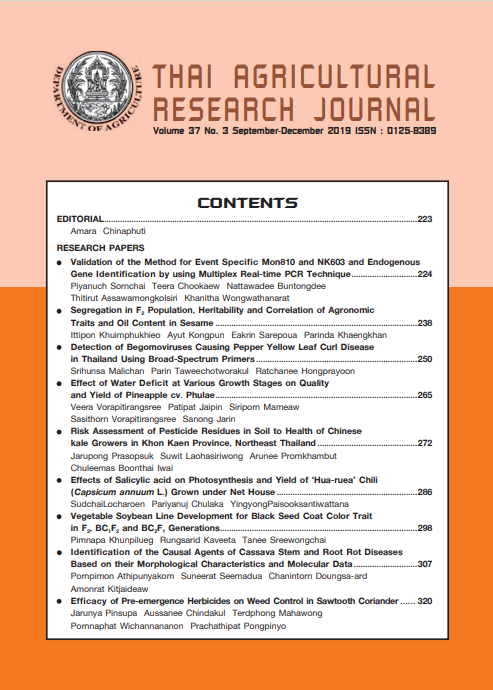Segregation in F2 Population, Heritability and Correlation of Agronomic Traits and Oil Content in Sesame
DOI:
https://doi.org/10.14456/thaidoa-agres.2019.20Keywords:
selection; yield; oil content, correlationAbstract
Sesame breeding to increase oil content and maintain acceptable agronomic traits is important to Thailand’s agriculture. The objectives of this study were to evaluate segregation, broad sense heritability and phenotypic correlation on agronomic traits and oil content in F2 population of KKU 1 x C-plus 2 and Mahasarakham 60 x Kanchanaburi. This study was carried out at Faculty of Agricultural Technology, Kalasin University. The agronomic traits of individual plant selected were recorded and oil content was analyzed.
The results showed that F2 population of both crosses demonstrated continuous segregation for agronomic traits and oil content. The genetics of parent used affected the oil content distribution of F2 population. The F2 population that came from crossing between high oil content cultivars tend to have higher number of individual plants with high oil content than those coming from crossing between low oil content cultivars. The twenty-five breeding lines of KKU 1 x C-plus 2 and the twenty-seven breeding lines of Mahasarakham
60 x Kanchanaburi were chosen by their good agronomic traits and high oil content for continued selection in F3 population. Heritability of agronomic traits and yield were low while heritability of oil content was moderate to relatively high. Significant positive correlation coefficients were found between oil content with branch/plant, length of capsule and yield/plant in KKU1 x C-plus 2. In contrast, correlation between oil content and agronomic traits for Mahasarakham 60 x Kanchanaburi in F2 population was not found.
References
เกษตรศาสตร์. 465 หน้า.
เกียรติศักดิ์ ฟั่นเพ็ง. 2553. การทดสอบสมรรถนะของสายพันธุ์และลักษณะที่เกี่ยวข้องกับศักยภาพการให้ผลผลิต และเปอร์เซ็นต์น้ำมันของทานตะวัน. วิทยานิพนธ์วิทยาศาสตรมหาบัณฑิต มหาวิทยาลัยเทคโนโลยีสุรนารี.
จักรกฤษณ์ ศรไชย และอริยาภรณ์ พงษ์รัตน์. 2558. ความแปรปรวนทางพันธุกรรมและอัตราพันธุกรรมในลักษณะผลผลิตและองค์ประกอบผลผลิตของงา (Sesamum indicum L.). วารสารการเกษตรราชภัฎ. 14: 56-61.
ลักขณา ร่มเย็น ประภาพร แพงดา อรอนงค์ วรรณวงษ์ บุญเหลือ ศรีมุงคุณ ศิริรัตน์ กริชจนรัช และพรพรรณ
สุทธิแย้ม. 2559. สถานการณ์การผลิตงาของประเทศไทย. วารสาร มทร.อีสาน (ฉบับพิเศษ). 9: 85-93.
อิทธิพล ขึมภูเขียว ปริญดา แข็งขัน เอกรินทร์ สารีพัว และอรวรรณ รักสงฆ์. 2560. อัตราพันธุกรรมและสหสัมพันธ์ของลักษณะทางการเกษตรและผลผลิตของงา (Sesamum indicum L.). วารสารพืชศาสตร์สงขลานครินทร์. 4: 1-9.
อิทธิพล ขึมภูเขียว ปริญดา แข็งขัน เอกรินทร์ สารีพัว และอรวรรณ รักสงฆ์. 2561. สมรรถนะการรวมตัวของผลผลิตและองค์ประกอบผลผลิตในงาลูกผสม. วารสารวิจัยและส่งเสริมวิชาการเกษตร. 35: 1-10.
Anilakumar, K.R., A. Pal, F. Khanum and A.S. Bawa. 2010. Nutritional, Medicinal and Industrial Uses of Sesame (Sesamum indicum L.) Seeds - An Overview. ACS. 75: 159-168.
Food and Agriculture Organization of the United Nations. 2019. Statistics. Available from: http://www.fao.org/faostat/en/#home [access 6 February 2019].
Kesmala, T., S. Jogloy, S. Wongkaew, C. Akkasaeng, N. Vorasoot and A. Patanothai. 2004. Heritability and phenotypic correlation of resistance to Peanut bud necrosis virus (PBNV) and agronomic traits in peanut. Songklanakarin J. Sci. Technol. 26: 129–138.
Onginjo, E.O. and P.O. Ayiecho. 2009. Genotypic variability in sesame mutant lines in Kenya. African Crop Science Journal. 17: 101-107.
Penalvo, J.L., S.M. Heinonen, A.M. Aura and H. Adlercreutz. 2005. Dietary sesamin is converted to enterolactone in humans. J. Nutr. 135: 1056-1062.
Sumathi, P., V. Muralidharan and N. Manivannan. 2007. Trait association and path coefficient analysis for yield and yield attributing traits in sesame (Sesamum indicum L). Madras. Agric. J. 94: 174-178.
Yamashita, K., Y. lizuka, T. Imai and M. Namiki. 1995. Sesame seed and its lignans produce marked enhancement of vitamin E activity in rats fed a low α –tocopherol diet. Lipids 30: 1019-1028.
Yingzhong, Z., and W. Yishou. 2002. Genotypic correlations and path coefficient analysis in sesame. Sesame and SafflowerNews. 17: 10-12.
Yol, E., E. Karaman, S. Furat, and B. Uzun. 2010. Assessment of selection criteria in sesame by using correlation coefficients path and factor analyses. AJCS. 4: 598-602.
Downloads
Published
How to Cite
Issue
Section
License
Copyright (c) 2020 Thai Agricultural Research Journal

This work is licensed under a Creative Commons Attribution-NonCommercial-NoDerivatives 4.0 International License.
Thai Agricultural Research Journal



